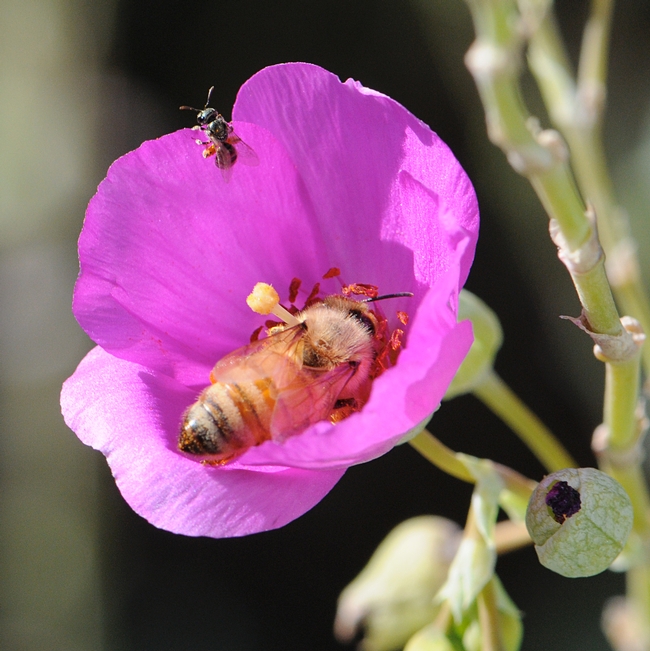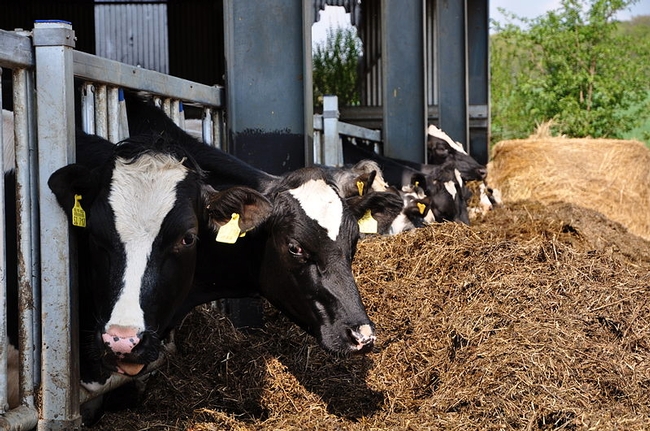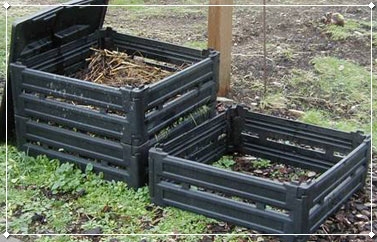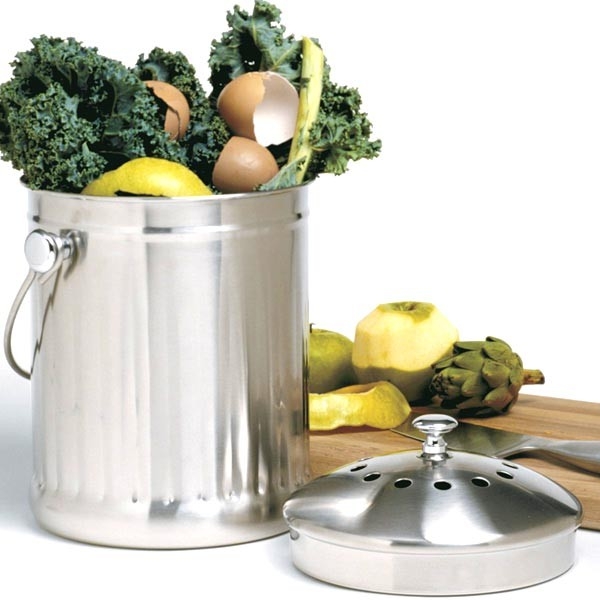From the UC Blogosphere...
Urban environments are refuges for bees
Holland focused on the work of Gordon Frankie, an urban entomologist at UC Berkeley. He has been studying the foraging habits of native bees in Costa Rica to find out how much they forage in urban gardens.
Costa Rica has 800 bee species; Gordon's team has collected 112. They found that in most cases, a plant specimen located in an urban setting attracts as many bee species as does its wild counterpart. Occasionally, city specimens actually get more bees than the wild ones. As many as 80 percent of the native bees observed in wild settings were also visiting the urban gardens.
“That was higher than we expected, and it gave us hope. As more natural areas are disappearing or being impacted by humans, urban areas offer something more stable — people are looking after them," Frankie said.
Frankie is also monitoring the status of native bees in California, where there are 1,600 species, the article said. Gordon and his team have found 90 species of bees in the San Francisco Bay Area and East Bay region. Gardeners can help local bees by putting the Best Bee Plants for California around their homes.
Frankie also has a new book for sale, California Bees and Blooms: A Guide for Gardeners and Naturalists, $28 from Heyday Books.
Why Do Honey Bees Die When They Sting
"Why do honey bees die when they sting?" That's the question PBS Newshour asked Extension apiculturist (retired) Eric...
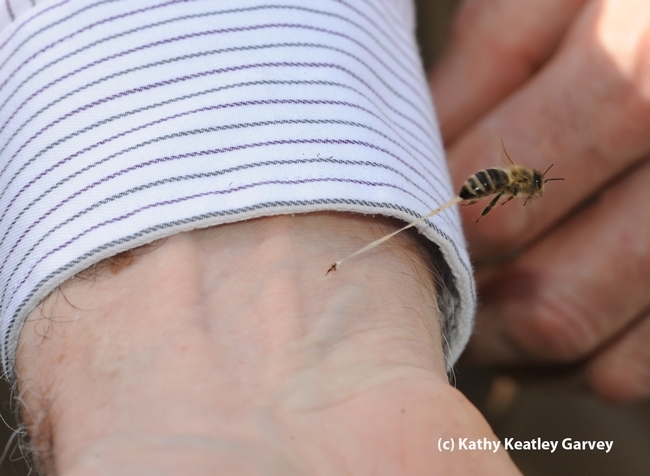
A honey bee embeds its stinger in the wrist of Eric Mussen and then tries to pull away. Note the abdominal tissue trailing. (This is an actual photo of a bee sting; it was not posed.) (Photo by Kathy Keatley Garvey)
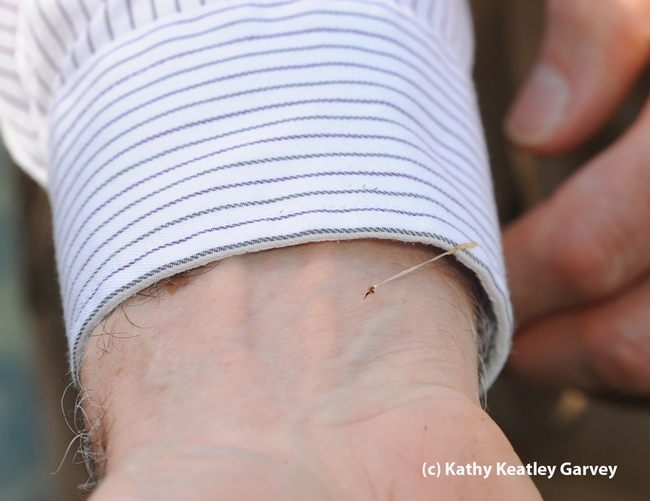
The bee has pulled away to die, leaving the stinger and abdominal tissue behind. (Photo by Kathy Keatley Garvey)
Humboldt County voters to weigh in on GMOs
Alison Van Eenennaam, UCCE specialist in the Department of Animal Science at UC Davis, said there are thousands of scientific studies that have shown that GMOs are not dangerous. Van Eenannaam herself published a review in September that examined 30 years of livestock-feeding studies that represent more than 100 billion animals. She concluded that the performance and health of food-producing animals consuming genetically engineered feed has been comparable to that of animals consuming non-GE feed.
Van Eenennaam cautioned the North Coast Journal reporter that "you can't just say 'GE is safe.'"
"That's too broad," she said. "That's like saying 'electricity is safe.' People who've been in the electric chair would disagree."
One can't say that traditional breeding is "safe," either. People have been breeding organisms to select for specific traits, and creating hybrids by crossing two species (such as a horse and donkey to get a mule) for thousands of years, the article said.
In San Luis Obispo County, where a measure banning GMOs failed in 2004, organic farmers are using buffers and communication with neighbors to allow farmers who use GMOs to coexist with non-GMO farmers.
"Coexistence is not a new idea,"said Mary Bianchi, director of SLO County UCCE. But it's been working. And, she says, nobody has pushed for a GMO-ban in San Luis Obispo County since.
The director of UC Cooperative Extension in Humboldt County, Yana Valachovic, said she and her office haven't taken a side in the debate over the Humboldt County measure.
She said she believes the issue boils down to one question: "Are we more concerned about the risks or more hopeful of the opportunities?"
A, B, and C: What They Really Stand for...
Give me an "A" (for excellence). Give me a "B" (for bee). Give me a "C" (for Cosmos). Watching honey bees collect nectar...
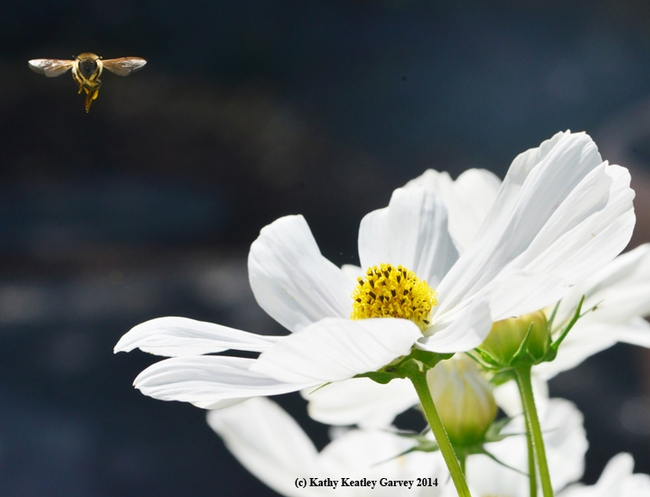
Honey bee heading for a Cosmos. (Photo by Kathy Keatley Garvey)
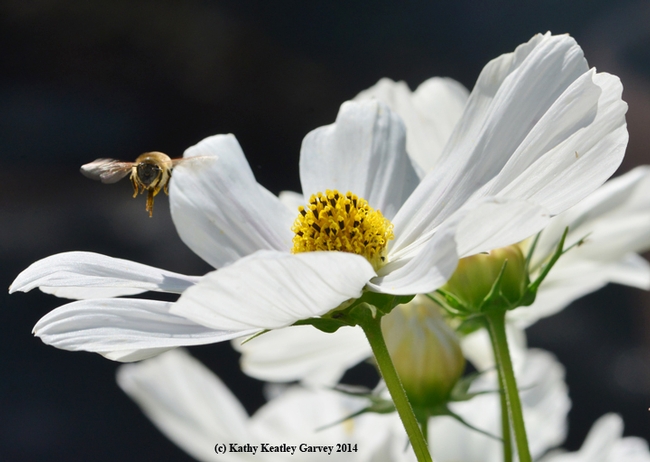
All the right moves. (Photo by Kathy Keatley Garvey)
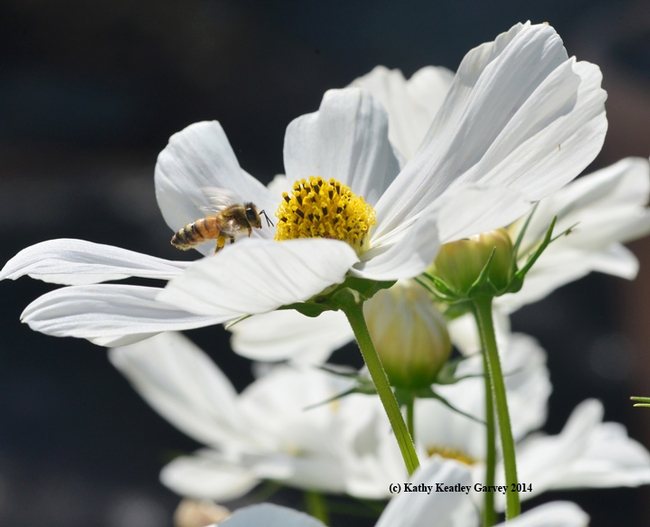
The grand entrance. (Photo by Kathy Keatley Garvey)
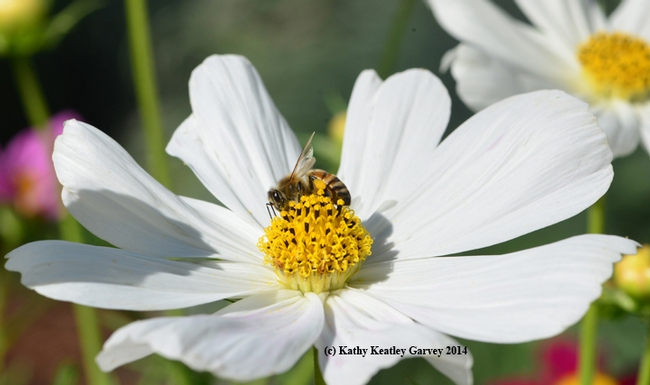
The reward: nectar and pollen. (Photo by Kathy Keatley Garvey)
Breaking it Down: Tips for Composting at Home
I started composting at my house a couple years ago. I had been eyeing an unused compost bin that my in-laws had in their back yard for a while, and when they finally offered it up to me, I was happy to take the bin off their hands and put it to use in my yard. Back when I lived in San Francisco I was always on top of what could go in the green waste bin, and what had to be put in the trash, and the same went for when we moved to Berkeley and when we moved to Walnut Creek. I love not putting things in the trash. Our recycling bin is usually the fullest bin on trash days. Since we have started composting some things still go in the city's green waste cart, but more and more goes into my personal compost bin. There was a bit of a learning curve at first, but now it is second nature to me (and its getting easier for my husband, too).
There are many reasons to compost: adding compost to your soil improves your soil's texture, fertility and ability to retain water. Compost adds microorganisms and other beneficial critters to your soil (I am always excited to see bugs and earthworms, and the occasional lizard hanging out in my bin). And when you add kitchen scraps to your compost bin you are keeping them out of the landfill - you are doing the ultimate form of recycling! I think composting can be intimidating to some people, but I am here to tell you that composting is not hard!
The compost bin I use is a Bio-Stack bin. Like I said earlier, I got it for free, so I am in no way advocating for this particular brand of bin, but I do enjoy it. It is light-weight and easy to make bigger or smaller as needed by adding or removing a layer. It also has a nice hinged lid that makes it easy to add new material to the pile. The lid comes off easily for watering and turning the compost. But if I did not have this bin, my plan was to just start a pile in the corner of my yard and compost the old-fashioned way. There is no need to buy anything to get a compost pile going!
I would say the one biggest hurdle to composting at my house was deciding, and learning along the way, what I wanted to have go in my compost pile, and what was still best to send off in the city's green bin. Our trash set up had always included a trash can, a recycling bin and a green-waste can, so I just added a fourth container: the compost container. If you are already in the habit of putting food waste (and other things like coffee filters and paper towels) in a green waste bin, then adding another bin for compost materials is not that hard. Our compost bin is one of these stainless steel buckets with a lid and handle:
It works really well for us. It gets full maybe once or twice a week, depending on what we are cooking. When it gets full I walk it out to the compost bin and dump it. If its super funky inside, I fill it up with the hose, swish it around a bit and then dump that water into the compost bin too. Since I am already out at the compost bin I will usually take my garden fork, which I keep by the compost bin and turn the pile.
There are certain food waste items that I could put in my compost pile that I choose to put in the city's green waste bin. If for some reason we are using a lot of paper towels, I put most of those in the city bin. I have also learned that avocado pits, stone fruit pits, corn cobs and corn husks take a really long time to break down, so I no longer put them in my compost pile. But you can easily learn what works for you. Some weeks it feels like most of what is going in the compost pile is egg shells and coffee grounds, but so far the compost police have not showed up and punished me for any lack of diversity in my pile.
Another admission on my part, I don't water my compost pile as often as I should. But the pile continues to break down, just at a slower pace. From my experience, I don't think you can really compost "wrong." There are certainly best practices to use, and ways to make your food waste break down faster, but I think some people get too caught up in balancing the greens and browns, and watering and turning the pile that they never start one in the first place! If you have a compost bin that does develop an issue - like flies, or a nasty smell, there is pretty much always an easy solution.
I know that my summer crop of tomatoes and beans benefited greatly from the home made compost that I added when I potted them, and I encourage you to give home composting a shot, too!
If you do want some more basic information on composting, here are some great links to get you going:
Composting for the Home Gardener



